The materials from which an instrument is constructed have much to do with how it sounds. This is especially evident in woodwind instruments, which vary greatly in construction and composition. Some of them aren't even made of wood any longer, and the modern saxophone has been made of brass - not wood at all - from the start. But most woodwind instruments are made of or contain polymers.
Much has been done to make these instruments more durable and easier to care for. This includes everything from oils and finishes which protect the wood, which is a natural polymer, to constructing the entire instrument (including the reeds) of syntheitc (or man-made) polymers which closely emmulate the sound of a wood instrument. The oils and finishes themselves are also made of natural or synthetic polymers.
And still other instruments - such as the flute and the piccolo have gone largely to metal construction, noticeably brightening the tone of the instruments. And, though synthetics have come a long way, there is little argument that a woodwind instrument made of WOOD has a rich and distinctive sound which is hard to duplicate with any man-made polymers.
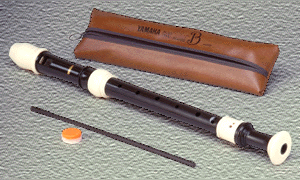 This modern recorder is made from tough
This modern recorder is made from tough
ABS resin. The bag to protect it is made of
vinyl and the cleaning rod is likely made of
polypropylene. |
It looks like a flute, but it's not. It's a recorder, one of the oldest members of the flute family. It dates back to the Rennaissance and before. It works a lot like a modern flute, but air is blown through it and not across it.
Roecorders were and still are made of wood (a few were even made from ivory - a type of protein). But now less costly plastic recorders are made. These are good for young students and non-professional players. Despite this, they are not toys just becuase they are plastic. In fact, many of them are precision instruments with a high quality sound. These plastic recorders are made from tough ABS resin, the same polymer used in car bumpers. This makes the recorder less subject to damage and wear. The plastic recorders may even be submerged in water for cleaning.
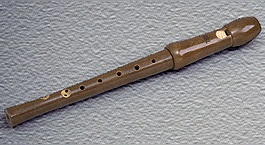 This little wood recorder is actually
This little wood recorder is actually
pretty affordable for someone getting
started, but it will require special care. |
Though a wood recorder has an even nicer sound, since wood is a natural polymer, namely cellulose, it is also much more in need of care. NO WATER ALLOWED! A wood recorder must be oiled on the inside to protect it from moisture, which can damage the wood and cause it to dry out and crack. It is also good to warm it up in one's hands before playing it. If the whole instrument is one temperature inside and out before it is played there is less accumulation of moisture and less stress on the wood. The joints of a wood recorder are where the pieces of the body are put together. They are made of soft cork - another form of cellulose - and must be treated with cork grease. A plastic recorder also needs an oil called "recorder cream" - a petrolium product much like Vaseline - on the joints so that it may be more easily put together and taken apart, and so the joints will seal properly. Oils and lubricants such as these can be made from natural or synthetic polymers
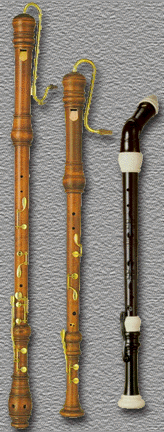 The bass and tenor recorders are so long that they have keys to cover the holes! The plastic bass has a bent neck for easier playing
The bass and tenor recorders are so long that they have keys to cover the holes! The plastic bass has a bent neck for easier playing |
Recorders come in a surprising variety of sizes, from tiny sopranino to massive bass and great bass. The larger instruments have plastic or metal keys and pads to cover the holes, which are too far apart to cover with the fingers. The keys operate much like those of an oboe or clarinet. And the pads that cover the holes are generally made from some sort of leather or kidskin, which are both proteins.
The reocorder is often taught to school children because it is a relatively easy instrument to get started on, but it is not a "kid's instrument." There is a great deal of difficult and complex music written for the recorder since it was around before the modern transverse flute. And the high quality wooden recorders played by professionals have a soft warm sound that is unmatched by plastic instruments. These recorders can cost thousands of dollars. So which is better - wood or plastic?

 Not too many polymers in a modern silver flute, except the
Not too many polymers in a modern silver flute, except the
pads and the oil. The irish flute,
however is a transverse
flute which is still made of wood.
|
Nowadays flutes are generally made of silver or silverplated nickel. But originally they were made of wood. A wooden flute has a distinctly different sound from a metal one. The natural plant fibers in the cellulose give it a "reedy" sound somewhat like a recorder. Some wood flutes have keys and some of them don't. And modern flutes have very comlpex key mehcanisms with felt pads which cover the holes. Some musiciains still perform on flutes made of wood because they simply prefer that "wood" sound or because this sound is more appropriate for older music.
 The ABS resin piccolo has a metal mouthpiece,
The ABS resin piccolo has a metal mouthpiece,
while the wood one can have a wood or metal
mouthpiece.
|
A piccolo is a lot like a flute, but even higher! This little instrument is made from wood or ABS resin and can have a wood or metal headjoint. And there are also piccolos made completely of metal - silver or silverplated nickel like flutes.

A fife
|
The joints in wood flutes and piccolos are - as with other woodwind instruments - made from cork, which must be oiled so it will remain soft. As with flutes, the modern piccolo has a complicated arrangement of metal keys. But this was not always so. The oldest piccolos were not transverse flutes at all. They were French instruments called flageolets or flauto piccolo in Italian, and much more like sapranino recorders, blown like a whistle, some with keys and some without. And they were made, of course, from wood.
A fife, on the other hand, is much like a modern wooden piccolo, except with only six holes and without keys (Fifes also come in metal). You'll see this instrument in lots of Revolutionary War re-enactments. For some reason back then soldiers liked high-pitched woodwind instruments.
Clarinets also come in resin and wood. They also are made in a variety of sizes, all the way up to the huge contrabass clarinet.
The preferred wood for modern clarinets and other larger wind instruments is grenedilla wood, an exotic dark African wood which is somehow perfectly "aged" to be suited to resonate sound in a wind nstrument. It has a consistency to it's grain and has a density which yeilds a rich dark tone. Some clarinets are constructed of rosewood, which has a beautiful color, but it
doesn't have quite the same quality to its sound. And a lot of older clarinets were made of boxwood, another dense hardwood.
Another important part of the clarinet which is made from polymers is the pads which cover many of the tone holes when the apropriate keys are pressed. If the pads are absent or damaged the sound sound can be severely impaired. So what are pads made of exactly? Find out more here.


Here is a clarinet and its boxwood and ivory predecessor, not really much difference except the complexity and amount of metal hardware.
|
But the thing that makes a clarinet make sound is the reed. Reeds are made of cane which is carefully cut and shaped. Cane is a tough, bamboo-like stuff - a form of cellulose with long straight fibers.

 The clarinet is a single reed instrument. To produce
The clarinet is a single reed instrument. To produce
a sound one must use a cane reed in the mouthpiaece
|
A single reed is placed in the ligature of the clarinet mouthpiece and when it is blown correctly, the reed vibrates against the mouthpiece and makes a smooth hum which vibrates the whole clarinet body to make that nice clear tone which we all hope to hear when someone plays a clarinet. Though canewood is pretty tough, the edge of a reed can be easily damaged, and if a reed is damaged the sound might not be what we hoped for, like a buzzing in the tone or the sound of escaping air. In this case the reed must be replaced or readjusted.
Synthetic plastic reeds have also been produced. And though they are not as easily damaged, and are technically "more consistent" they still don't vibrate quite as well as the real thing. Supposedly synthetic reeds are getting closer and closer to soundng like the real thing.
Saxophones
Another single reed instrument is the saxophone. Yeah, it is made of brass but it is a woodwind instrument because the sound is generated by the vibration of a reed, which is placed in a plastic or rubber mouthpiece just like on a clarinet. (And some sax mouthpieces are even made of metal.)
The ligature on the mouthpiece of a sax or a clarinet, which holds the reed in place, can be made of metal fabric or string. Fabric and string are generally made of cellulose - plant fibers such as cotton. And the pads on the sax are made of leather or goatskin.
 Saxophones vary greatly in length
Saxophones vary greatly in length
and sound.
|
The saxophne - like many other instruments comes in an array of sizes. If the instruments in this picture were to scale you could really see an even bigger difference between the different sizes - from the soprano to the baritone. A bass sax is REALLY BIG. More instrument means a lower sound, and the vibration of the reed through its brass body gives a sax a much different sound than that of a brass instument like a trumpet or a horn. Thanks to polymers!
 These are double reeds used on
These are double reeds used on
oboes, English horns and bassoons.
|
A few of the woodwinds employ two reeds in order to make sound. The cane reeds are placed against each other and the player holds them between the lips and blows air though them. They vibrate together and cause the whole instrument to make sound. The type of sound is determined by what type of instrument is attached to the reeds.
The double reeds seem to give this family of instruments a sort of "nasal" closed sound. The oboe and the English horn - which is longer - are constructed much like a clarinet, with a long wooden or resin body and lots of shiny metal keys. They also have cork joints and lots of pads to cover the holes.

The bassoon streatched out would be about 9 feet (almost 3 meters) long!
|
The bassoon is a larger version of the oboe which is about nine feet long! It has a bore which is doubled back on itself so that the player doesn't have to stand on a ladder to play it. The sound comes out of the top instead of the bottom. Since it is so long it makes a deep dark sound. Some of the older French bassoons made of maple wood have a brighter more oboe-like sound - but over time people opted for the darker sounding German version made of grenedilla wood or rosewood. (For an even deeper, darker sound, try the contrabassoon!) But bassoons are not made exclusively of wood. Like clarinets and oboes a bassoon may also be costructed of ABS resin.
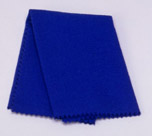
Cotton polishing
cloths
|
A "key" component in the care of woodwind instruments is oil - for the keys, the wood, the joints, and the finish. Woodwinds that are made of wood have to be oiled inside and out. And all of the numerous different synthetic and natural oils used on woodwinds are polymers! The outsides of many wood instruments are finished in either laquer or polyester, to keep them smooth and shiny, and to protect them. These finishes are strong protective polymers, but they must be maintained by occasional polishing with silicone oils and natural waxes which are formulated to clean and polish at the same time. Also soft polishing clothes usually made of brushed cotton are used in this cleaning.

Cork grease comes in
a tube like Chapstick
|
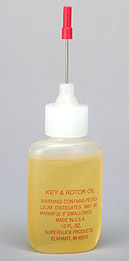
A bottle of
key oil
|
The joints of all recorders, flutes, clarinets, etc, must be cleaned and greased often with cork grease to keep them soft so that a good tight seal between the pieces of the body is maintained. And instruments with keys - flutes, clarinets, saxaphones, etc - must have the keys oiled to keep the action smooth and to keep them from sticking. And the cellulose or leather pads must also be cleaned and changed from time to time.
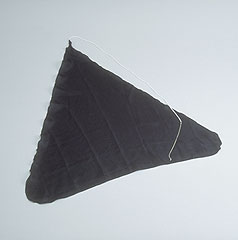
A silk swab is pulled
through the instrument
to absorb moisture
|
Another concern is moisture, even in resin or plastic instruments. Most of the time the insides of an instrument will not be as warm as the human body playing it. So when someone blows warm, humid lung air through it, condensation results. Thus a wooden instrument must be oiled on the inside with bore oil, to protect the wood. And all woodwinds should be swabbed out after use. A common material for swabs is silk, a natural polymer, becasue it is thin enough to pull through the bore in the center of an instrument and it is extremely absorbant and lent free.
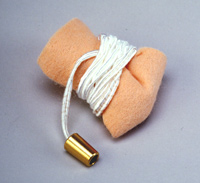
Wool is also an
absorbant materail
good for swabs
|
Many people think these silk swabs are for spit - which is more of a problem in brass instruments. In woodwinds the moisture is more like "lung juice." When the inside surface of an instrument is cooler than the warm moist breath moving through it, the moisture in the breath condenses into liquid which builds up inside the instrument. One method of reducing moisture during playing is to warm the instrument before playing it. If it is warmed with the hands for a few minutes prior to playing the amount of condensation inside can be reduced.
So take care of your woodwinds, and they will take care of you. Also don't forget to enjoy playing! And remember that one of the things that allows you to have so much fun playing music is polymers!

Sources for this page | HOME | Instrument Index | Polymer Science Learning Center | TOP




 The bass and tenor recorders are so long that they have keys to cover the holes! The plastic bass has a bent neck for easier playing
The bass and tenor recorders are so long that they have keys to cover the holes! The plastic bass has a bent neck for easier playing

















